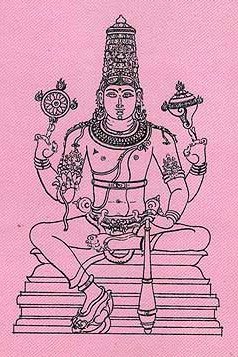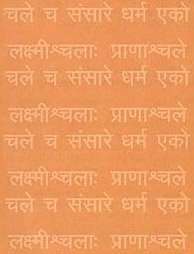Nastika, Nāstika, Nashtika, Nāṣṭika, Nāstikā, Naṣṭikā: 20 definitions
Introduction:
Nastika means something in Buddhism, Pali, Hinduism, Sanskrit, Jainism, Prakrit, Marathi, Hindi. If you want to know the exact meaning, history, etymology or English translation of this term then check out the descriptions on this page. Add your comment or reference to a book if you want to contribute to this summary article.
The Sanskrit terms Nāṣṭika and Naṣṭikā can be transliterated into English as Nastika or Nashtika, using the IAST transliteration scheme (?).
Alternative spellings of this word include Nastik.
In Hinduism
Pancaratra (worship of Nārāyaṇa)
Source: eScholarship: Chapters 1-14 of the Hayasirsa PancaratraNāstika (नास्तिक) refers to “one who is a non-believer”, representing an undesirable characteristic of an Ācārya, according to the 9th-century Hayaśīrṣa-pañcarātra Ādikāṇḍa chapter 3.—The Lord said:—“I will tell you about the Sthāpakas endowed with perverse qualities. He should not construct a temple with those who are avoided in this Tantra. [...] He should not be a Punarbhū, a Svayambhū, a widow’s bastard, or a non-believer (nāstika), nor irrational, pale, bald or crippled or fat. [...] A god enshrined by any of these named above (viz., nāstika), is in no manner a giver of fruit. If a building for Viṣṇu is made anywhere by these excluded types (viz., nāstika) then that temple will not give rise to enjoyment and liberation and will yield no reward, of this there is no doubt”.
Note: Nāstika refers to “one who denies the authority of the Vedas” (Gupta, 1983:70), this includes not only groups within Hinduism but also Buddhists and Jains. The incorporation of Vedic elements, and stressing the importance of the Vedas is another, relatively, late development in the Pāñcarātra tradition, indicating its Brahmanicization.

Pancaratra (पाञ्चरात्र, pāñcarātra) represents a tradition of Hinduism where Narayana is revered and worshipped. Closeley related to Vaishnavism, the Pancaratra literature includes various Agamas and tantras incorporating many Vaishnava philosophies.
Mīmāṃsā (school of philosophy)
Source: academia.edu: Religious Inclusivism in the Writings of an Early Modern Sanskrit Intellectual (mimamsa)Nāstika (नास्तिक) refers to the “extra-Vedic traditions”.—[...] While it is true, for instance, that Madhusūdana adopts an inclusive attitude towards Veda-affirming schools in his Prasthānabheda—including in its harmonizing scheme of ‘sciences’ (vidyā) both Vaiṣṇava and Śaiva teachings, among others—yet he explicitly excludes the extra-Vedic (nāstika) traditions of the Buddhists, Jains and materialists, as well as the paths or methods (prasthāna) of Mlecchas. His rejection of those schools is unambiguous and based on a typically orthodox criterion—externality to the Vedic tradition. Although it offers a comparatively unified picture of āstika schools, Madhusūdana’s doxographical scheme is not all-inclusive, and retains an orthodox character insofar as it denies legitimacy to extra-Vedic traditions and those traditions associated with outcastes.

Mimamsa (मीमांसा, mīmāṃsā) refers to one of the six orthodox Hindu schools of philosophy, emphasizing the nature of dharma and the philosophy of language. The literature in this school is also known for its in-depth study of ritual actions and social duties.
Yoga (school of philosophy)
Source: Brill: Śaivism and the Tantric Traditions (yoga)Nāstika (नास्तिक) refers to “those who deny the validity of scripture”, according to the Yogapañcāśikā, a 16th-century text dealing with Yoga in 50 verses.—The Yogapañcāśikā teaches an aṣṭāṅgayoga. The first four auxiliaries are Haṭhayoga, and the second four, Rājayoga. It is a Śaiva work that aims at raising kuṇḍalinī, uniting Śakti with Śiva and attaining jīvanmukti, followed by videhamukti when all prārabdakarma is extinguished. Its Yoga is not intended for those who deny the validity of scripture (nāstika), but for male life-long Brahmacārins (nṛnaiṣṭhika).

Yoga is originally considered a branch of Hindu philosophy (astika), but both ancient and modern Yoga combine the physical, mental and spiritual. Yoga teaches various physical techniques also known as āsanas (postures), used for various purposes (eg., meditation, contemplation, relaxation).
General definition (in Hinduism)
Source: WikiPedia: HinduismThe main schools of Indian philosophy that do not base their beliefs on the Vedas were regarded as heterodox by Brahmins:
- Buddhism
- Jainism
- Cārvāka
- Ājīvika
Tantric traditions in Hinduism have both āstika and nāstika lines;
Source: Shodhganga: A study of Nyāya-vaiśeṣika categories (h)Nāstika (नास्तिक, “heterodox systems”).—Some other systems of Indian Philosophy do not accept the Vedic authority. These systems are called nāstika or heterodox systems, viz. the Bauddha, the Jaina and the Cārvāka. Āstika and nāstika are the two broad divisions of Indian philosophy. According to Pāṇini, āstika is ‘one who believes in the other world’, nāstika is ‘one who does not believe in the other world’ and daiṣṭika is a predestinarian’ or ‘fatalist’. This is the oldest recorded explanation of these words”.
Generally āstika means one who believes in the existence of God and nāstika means one who does not believe in the existence of God. However, according to the philosophers, those schools are called āstika, which accept the Vedic authority and those schools are named nāstika, which do not accept the Vedic authority.
In Buddhism
Tibetan Buddhism (Vajrayana or tantric Buddhism)
Source: academia.edu: The Structure and Meanings of the Heruka MaṇḍalaNāstikā (नास्तिका) is the name of a Ḍākinī who, together with the Vīra (hero) named Nāsticinta forms one of the 36 pairs situated in the Vākcakra, according to the 10th century Ḍākārṇava chapter 15. Accordingly, the vākcakra refers to one of the three divisions of the nirmāṇa-puṭa (emanation layer’), situated in the Herukamaṇḍala. The 36 pairs of Ḍākinīs [viz., Nāstikā] and Vīras are reddish madder in color; they each have one face and four arms; they hold a skull bowl, a skull staff, a small drum, and a knife.

Tibetan Buddhism includes schools such as Nyingma, Kadampa, Kagyu and Gelug. Their primary canon of literature is divided in two broad categories: The Kangyur, which consists of Buddha’s words, and the Tengyur, which includes commentaries from various sources. Esotericism and tantra techniques (vajrayāna) are collected indepently.
In Jainism
General definition (in Jainism)
Source: academia.edu: The Original Paṇhavāyaraṇa/Praśnavyākaraṇa DiscoveredNaṣṭikā (नष्टिका) refers to the “(identity of the) lost object”, as taught in the Paṇhavāgaraṇa (Sanskrit: Praśnavyākaraṇa): the tenth Anga of the Jain canon which deals with the prophetic explanation of queries regarding divination.—The Praśnavyākaraṇa deals with the praśnavidyā in a rather complex way. It is divided into at least 33 short chapters [e.g., naṣṭikā-jñāna-prakaraṇa], some of which are further divided into sub-chapters. Some contents of the text, mainly those related with articulation and pronunciation can have significance far beyond the scope of the praśnavidyā.

Jainism is an Indian religion of Dharma whose doctrine revolves around harmlessness (ahimsa) towards every living being. The two major branches (Digambara and Svetambara) of Jainism stimulate self-control (or, shramana, ‘self-reliance’) and spiritual development through a path of peace for the soul to progess to the ultimate goal.
Languages of India and abroad
Marathi-English dictionary
Source: DDSA: The Molesworth Marathi and English Dictionarynāstika (नास्तिक).—m (S) An atheist or infidel; one who denies God or a future world or the divine authority of Vedas and Puran̤s.
Source: DDSA: The Aryabhusan school dictionary, Marathi-Englishnāstika (नास्तिक).—m An atheist.
Marathi is an Indo-European language having over 70 million native speakers people in (predominantly) Maharashtra India. Marathi, like many other Indo-Aryan languages, evolved from early forms of Prakrit, which itself is a subset of Sanskrit, one of the most ancient languages of the world.
Sanskrit dictionary
Source: DDSA: The practical Sanskrit-English dictionaryNāṣṭika (नाष्टिक).—The owner of anything lost; नाष्टिको लभते धनम् (nāṣṭiko labhate dhanam) Manusmṛti 8.22.
Derivable forms: nāṣṭikaḥ (नाष्टिकः).
--- OR ---
Nāstika (नास्तिक).—a. (-kaḥ) [नास्ति परलोकस्तत्साधनमदृष्टं तत्साक्षीश्वरो वा इति मतिरस्य ठन् (nāsti paralokastatsādhanamadṛṣṭaṃ tatsākṣīśvaro vā iti matirasya ṭhan)] An atheist, unbeliever, one who denies the authority of the Vedas and a future life or the existence of a Supreme Ruler or Creator of the Universe; अतिमात्रोज्झितभीरनास्तिकः (atimātrojjhitabhīranāstikaḥ) Śiśupālavadha 16.7; Manusmṛti 2.11; 8.22. नासाचूर्णे नास्ति कस्याभिलाषः नासाचूर्णे नास्तिकस्याभिलाषः (nāsācūrṇe nāsti kasyābhilāṣaḥ nāsācūrṇe nāstikasyābhilāṣaḥ) Subhāṣ.
Source: Cologne Digital Sanskrit Dictionaries: Shabda-Sagara Sanskrit-English DictionaryNāṣṭika (नाष्टिक).—mfn.
(-kaḥ-kī-kaṃ) Belonging or relating to any thing lost. m.
(-kaḥ) The owner of any thing lost. E. naṣṭa, and ṭhak aff.
--- OR ---
Nāstika (नास्तिक).—m.
(-kaḥ) An atheist, but applied by the orthodox Hindus, to any one who denies the divine authority of the Vedas, or doubts the legends of the Puranas, or a future life or the existence of a ruler, or creator of the universe. E. nāsti there is not (a god &c.) and ṭhan aff.
Source: Cologne Digital Sanskrit Dictionaries: Benfey Sanskrit-English DictionaryNāṣṭika (नाष्टिक).—i. e. naṣṭa (vb. 2. naś) + ika, m. The former owner who has lost a chattel.
--- OR ---
Nāstika (नास्तिक).—i. e. na-asti (vb. 1. as) + ka, m. An unbeliever, [Mānavadharmaśāstra] 2, 11.
Source: Cologne Digital Sanskrit Dictionaries: Cappeller Sanskrit-English DictionaryNāṣṭika (नाष्टिक).—[masculine] the owner of anything lost.
--- OR ---
Nāstika (नास्तिक).—[adjective] & [masculine] atheist(ical), sceptic(al).
Source: Cologne Digital Sanskrit Dictionaries: Monier-Williams Sanskrit-English Dictionary1) Nāstika (नास्तिक):—[from na] a mf(ī)n. atheistical, infidel
2) [v.s. ...] m. an atheist or unbeliever (opp. to āstika q.v.), [Manu-smṛti; Mahābhārata] etc.
3) Nāṣṭika (नाष्टिक):—[from nāśa] mf(ī)n. ([from] naṣṭa) relating to anything lost, [Horace H. Wilson]
4) [v.s. ...] m. the (former) owner of any l° object, [Manu-smṛti viii, 202.]
5) Nāstika (नास्तिक):—b etc. See under 2. na.
Source: Cologne Digital Sanskrit Dictionaries: Yates Sanskrit-English Dictionary1) Nāṣṭika (नाष्टिक):—[(kaḥ-kī-kaṃ) a.] Lost. m. Owner of what is lost.
2) Nāstika (नास्तिक):—(kaḥ) 1. m. An atheist.
Source: DDSA: Paia-sadda-mahannavo; a comprehensive Prakrit Hindi dictionary (S)Nāstika (नास्तिक) in the Sanskrit language is related to the Prakrit words: Ṇatthia, Ṇāhiya.
[Sanskrit to German]
Sanskrit, also spelled संस्कृतम् (saṃskṛtam), is an ancient language of India commonly seen as the grandmother of the Indo-European language family (even English!). Closely allied with Prakrit and Pali, Sanskrit is more exhaustive in both grammar and terms and has the most extensive collection of literature in the world, greatly surpassing its sister-languages Greek and Latin.
Hindi dictionary
Source: DDSA: A practical Hindi-English dictionaryNāstika (नास्तिक) [Also spelled nastik]:—(nm) an atheist, unbeliever; ~[tā] atheism, disbelief (in the existence of God); —[darśana] atheistic philosophy.
...
Kannada-English dictionary
Source: Alar: Kannada-English corpusNāstika (ನಾಸ್ತಿಕ):—[adjective] believing that there is no god.
--- OR ---
Nāstika (ನಾಸ್ತಿಕ):—
1) [noun] a man who believes that there is no God; an atheist.
2) [noun] a man who does not recognise the authority of the Vēdas (gen. applied to a man belonging to Buddhism, Jainism, etc.).
3) [noun] any religion that does not recognise the Vēdas.
Kannada is a Dravidian language (as opposed to the Indo-European language family) mainly spoken in the southwestern region of India.
See also (Relevant definitions)
Starts with: Nashtikajnana, Nastikadarshana, Nastikadharma, Nastikamata, Nastikan, Nastikata, Nastikatana, Nastikatavadi, Nastikate, Nastikatva, Nastikavada, Nastikavadi, Nastikavadin, Nastikavritti.
Ends with: Anastika, Bhrishanastika, Vanastika.
Full-text (+15): Astika, Nastikata, Nastikya, Nastikamata, Nastikavritti, Durduruta, Nastikatva, Nahiya, Nastikavadi, Natthia, Hastavapa, Bhrishanastika, Vedanindaka, Natthika, Visampadayati, Ajivika, Nastik, Mokshashastra, Daishtika, Vijnanatma.
Relevant text
Search found 47 books and stories containing Nastika, Nāstika, Nashtika, Nāṣṭika, Nāstikā, Naṣṭikā; (plurals include: Nastikas, Nāstikas, Nashtikas, Nāṣṭikas, Nāstikās, Naṣṭikās). You can also click to the full overview containing English textual excerpts. Below are direct links for the most relevant articles:
Anumana in Indian Philosophy (by Sangita Chakravarty)
(B). A Note on Vedic schools < [Chapter 1 - Introduction]
Philosophy of Charaka-samhita (by Asokan. G)
Darśanas (philosophical speculations) < [Chapter 1 - Introduction]
Verbal Testimony (śabda) [in Charaka philosophy] < [Chapter 6 - Source of Knowledge (pramāṇa)]
The Foundational “Self” (cetanādhātu) < [Chapter 4 - Self (Puruṣa)]
The validity of Anumana (inference) in Nyaya system (by Babu C. D)
A History of Indian Philosophy Volume 3 (by Surendranath Dasgupta)
Dvisahasri of Tembesvami (Summary and Study) (by Upadhyay Mihirkumar Sudhirbhai)
Incorporation of Grammar in the Dvisāhasrī < [H. H. Ṭembesvāmī: Erudition]
Yoga-sutras (Ancient and Modern Interpretations) (by Makarand Gopal Newalkar)
Related products
